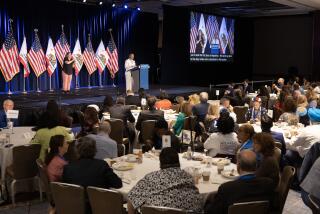Cadavers Join the Ballroom Crowd
- Share via
NEWPORT BEACH — The elegant ballroom at the Four Seasons hotel has been the scene of many gala gatherings. But on Saturday, it looked more like a scene from “ER.”
Beneath the glittering chandeliers, doctors huddled over seven cadavers draped in blue, studying what some call cutting-edge techniques in pain management.
They watched as one physician inserted needles and catheters into the spinal area of a well-covered cadaver, demonstrating a process in which medication can be applied to ease cervical pain.
About 70 doctors paid $1,300 apiece to attend this weekend workshop on pain management techniques at one of Orange County’s fanciest hotels.
“What we try to do is give people a way to train in a clinical way in a nonclinical setting,” said Joseph Krieger of Meeting Management Services, Inc., which organized the workshop. Doctors can bring their families, “relax a little bit,” he said. “We bring the cadavers to the ballroom.”
Another such workshop is planned for next month at the Hyatt Regency New Orleans.
“Nonclinical” certainly describes the atmosphere at the Four Seasons, with its eminently tasteful decor, classical music, original art and sculpture, piped classical music and neatly-folded cloth towels in the restrooms.
The Saturday menu included steamed lobster with chanterelles and cappellini, prime New York steak with vegetable gratin and violet mustard. The entrance drive was studded with Mercedes and BMWs.
Guests in designer garb glided through the wide hallways, apparently oblivious to the ersatz operating room behind the doors of Ballroom Salon A.
There, the long white-draped banquet table was covered, not with champagne glasses and strawberries on ice but with stacks of lead aprons, intended to shield doctors from X-ray equipment.
The room temperature was bone-chilling, much like a real operating room.
In this plush, tan-and-mauve ballroom decor, the seven fresh-frozen cadavers lay covered on tables, ringed with medical equipment. Most cadavers were torsos, although some had heads and necks, organizers said. On each, only a small portion of red-brown skin was visible amid the blue fabric covering.
Fluoroscopic equipment allowed doctors to literally see inside the cadavers via images on a nearby screen. So as a needle was inserted into the spinal area, the doctors could scrutinize its nearness to the vertebrae.
A key figure at the workshop was Dr. Gabor Racz, professor, chairman of anesthesiology and director of a pain clinic at Texas Tech University’s Health Sciences Center in Lubbock.
Among the techniques Racz uses is one that involves accessing nerve roots in the spine using catheters and then applying medication to soothe pain. That approach can ease pain caused by such problems as herniated discs and whiplash, advocates say.
Racz calls the technique less invasive than surgery.
“The incidence of surgery goes down dramatically in our patients,” he said.
The cadavers came from anatomical gift programs in which people donate their bodies to medical schools, said Elizabeth Rathburn of International Biological, Inc. of Roseville, Mich., which supplied the cadavers.
Dr. Hugh Stallworth, Orange County director of public health, said that to his knowledge, the workshop would not need his agency’s clearance to use cadavers.
And Four Seasons hotel manager Joel Graham said: “We do not get involved in the group activity. As far as what’s going in there, we do not know. . . . It’s group business, as far as we’re concerned.”
Racz commended those who donate their bodies to science. The only alternative would be teaching delicate techniques on live people--and with cadavers, mistakes can be caught early on, he said.
“People need to be given credit for contributing their bodies,” he said. “As you can see, they’re treated with respect.”
More to Read
Sign up for The Wild
We’ll help you find the best places to hike, bike and run, as well as the perfect silent spots for meditation and yoga.
You may occasionally receive promotional content from the Los Angeles Times.






